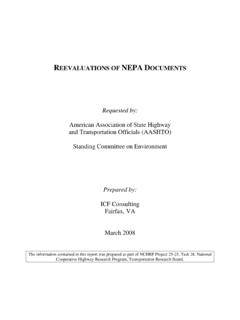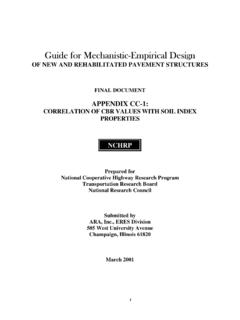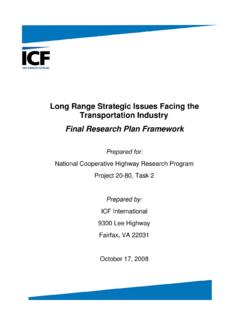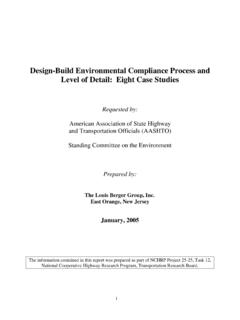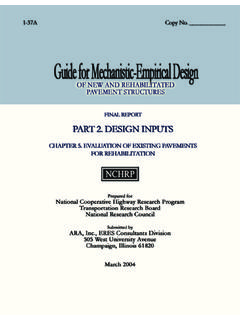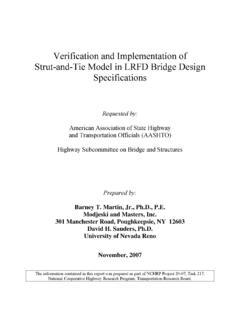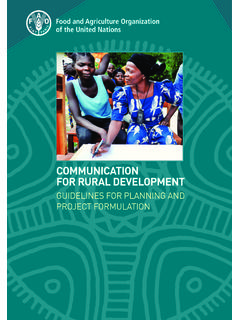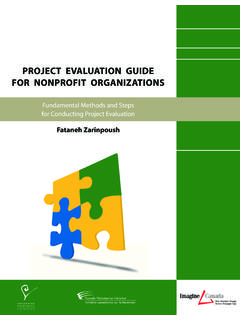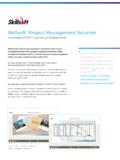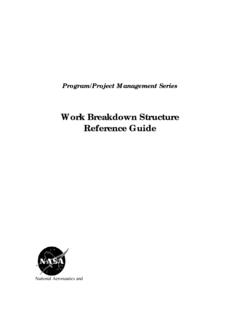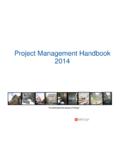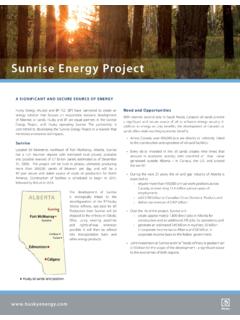Transcription of Effective Project Management for NEPA Prepared for
1 Page iEffective Project Management for NEPAP repared for:American Association of State Highway and Transportation Officials (AASHTO)Standing Committee on the EnvironmentPrepared by:ICF InternationalAugust 2008 The information contained in this report was Prepared as part of NCHRP Project 25-25, Task 27 National Cooperative Highway Research Program, Transportation Research Board. Page iiAcknowledgementThis study was requested by the American Association of State Highway and Transportation Officials (AASHTO), and conducted as part of the National Cooperative Highway Research Program (NCHRP) Project 25-25. The NCHRP is supported by annual voluntary contributions from the state Departments of Transportation. Project 25-25 is intended to fund quick response studies on behalf of the AASHTO Standing Committee on the Environment..The report was Prepared by Chris Paulsen of ICF Consulting was the Principal Investigator.
2 Tanvi Lal of ICF Consulting and Marie Venner of Venner Consulting, Inc. provided support. The work was guided by a task group chaired by Brent Jensen which included Kelly Dunlap, Bill Hauser, Tim Hill, Shane Marshall, and Neel Vanikar. The Project was managed by Christopher Hedges, NCHRP Senior Program Officer. DisclaimerThe opinions and conclusions expressed or implied are those of the research agency that performed the research and are not necessarily those of the Transportation Research Board or its sponsors. The information contained in this document was taken directly from the submission of the authors. This document is not a report of the Transportation Research Board or of the National Research Council. Reference herein to any specific commercial product, process, or service by trade name, trademark, manufacturer, or otherwise does not necessarily constitute or imply its endorsement, recommendation, or favoring by NCHRP, the Transportation Research Board or the National Research iiiTable of ContentsList of Acronyms.
3 V1 Introduction .. Study Overview and Literature Web-based Survey and Telephone Concerns Related to Managing nepa Concerns Related to Project Training and Organization of the Remainder of this 142 The Role of the nepa Project Manager .. 153 Importance of Project Management in the nepa Process .. 164 Earlier Decision-making: Linking Planning and nepa .. SAFETEA-LU and Long-Range Planning and Environmental Guidance for Implementing Planning and Environmental DOT Examples of Linking Planning and Getting Started FHWA 245 Scoping Process Improvements at Scoping for Importance of Documentation of the Scoping DOT Scoping Process 276 Management of the nepa Purpose and Development and Consideration of Affected Mitigation and Public Involvement - A Clear, Open, Transparent Context Sensitive Preparing Quality 647 Project Management .
4 Risk Management : What is it? How to Approach Schedule Systems to Manage Project Work, Environmental Permits and Human Resources Training: Know nepa and Inter-relating 83 Conclusion .. 86 Page ivList of ExhibitsExhibit 1. Geographic Distribution of In-Depth Telephone Interview 2. Exhibit Risk Types Covered in a FDOT Risk-Based Graded Approach 3. Florida DOT Risk-Based Graded Approach Worksheet ..72 Exhibit 4. Florida DOT Risk-Based Graded Approach Worksheet ..73 AppendicesAppendix A Annotated BibliographyAppendix B Web-based Survey and RespondentsAppendix C Telephone Interview Questions and RespondentsAppendix D State DOT nepa ManualsPage vList of AcronymsADTA verage Daily TrafficAASHTOA merican Association of State highway and Transportation OfficialsCaltransCalifornia Department of Transportation DepartmentCAPC ommunicating all Processes (KYTC)CARTC ommunication Access Realtime TranslationCDOTC olorado Department of TransportationCECategorical ExclusionCEDARC omprehensive Environmental Data and Reporting systemCEQC ouncil on Environmental QualityCEQAC alifornia Environmental Quality ActCETASC ollaborative Environmental and Transportation Agreement for Streamlining (Oregon DOT)
5 CEVPCost Estimation Validation ProcessCFRCode of Federal RegulationsCOEUS Army Corps of EngineersCOTSC ommercial Off the ShelfCRACost Risk AssessmentCSSC ontext Sensitive SolutionsCTSC omment Tracking SystemCWAC lean Water ActDAGD esign Advisory GroupDEISD raft Environmental Impact StatementDLGD igital Line GraphDOTDD epartment of Transportation and Development (Louisiana)DOTsDepartments of TransportationEAEnvironmental AssessmentECBE nvironmental Competency BuildingECME nterprise Content Management (WSDOT)ECOPACE nvironmental Commitments and Obligations Package (NYSDOT)ECRE nvironmental Commitments Record (Caltrans)EISE nvironmental Impact StatementEMEnvironmental Monitor Toolkit (MDSHA)Page viEMSE nvironmental Management SystemEOExecutive OrderEPAUS Environmental Protection AgencyEPDE nvironmental Programs Division (MDSHA)EPICE nvironmental Permits, Issues and Commitments (TxDOT)ESAE ndangered Species ActESTE nvironmental Screening ToolETDM Efficient Transportation Decision-Making Process (FDOT)ETRACKNYSDOT Tracking DatabaseETSE nvironmental Tracking SystemFDOTF lorida Department of TransportationFEISF inal Environmental Impact StatementFHWAF ederal Highway AdministrationFONSIF inding of No Significant ImpactFTAF ederal Transit AdministrationGISG eographic Information SystemHOVHigh-Occupancy VehicleHOTHigh-Occupancy/TollITDI daho Transportation DepartmentiPMIntegrated Project Management (VDOT)KYTCK entucky Transportation CabinetLEDPAL east Environmentally Damaging Practicable AlternativeLOSL evel of ServiceMDEM aryland Department of EnvironmentMDOTM ichigan Department of TransportationMDSHAM aryland State Highway AdministrationMMRRM itigation Monitoring and Reporting Record (Caltrans)
6 Mn/DOTM innesota Department of TransportationMoDOTM issouri Department of TransportationMOAM emorandum of AgreementMOUM emorandum of UnderstandingMPOM etropolitan Planning OrganizationNCDOTN orth Carolina Department of TransportationNCHRPN ational Cooperative Highway Research ProgramNDOTN evada Department of TransportationPage viiNEPAN ational Environmental Policy ActNHIN ational Highway InstituteNHPAN ational Historic Preservation ActNJDOTNew Jersey Department of TransportationNMDOTNew Mexico Department of TransportationNPDESN ational Pollutant Discharge Elimination SystemNYDOTNew York State Department of TransportationODOTOhio Department of TransportationODOTO regon Department of TransportationPAMP ermits, Agreements, and Mitigation (Caltrans)PDCAPlan-Do-Check-ActPD & EProject Development and Environmental ManualPDFP ortable Document FormatPDPP roject Development ProcessPEARP reliminary Environmental Analysis Report (Caltrans)PELP lanning and Environmental LinkagePennDOTP ennsylvania Department of TransportationPMProject Management / Project ManagerPMPP roject Management PlanPMRSP roject Management and Reporting System (WSDOT)PPMSP rogram Project Management System (NMDOT)PRSMP roject Resourcing and Schedule Management (Caltrans)PS&EPlans, Specifications, and EstimatesPSRP roject Study ReportQA/QCQuality Assurance/Quality ControlQFDQ uality Function DeploymentQPQuality PlanningREResident EngineerReTRACReno Transportation Rail Access CorridorRODR ecord of DecisionROWR ight-of-WaySAFETEA-LUSafe, Accountable, Flexible, Efficient Transportation Equity Act.
7 A Legacy for Users SCOES tanding Committee on the Environment (AASHTO)SDDOTS outh Dakota Department of TransportationPage viiiSHOPPS tate Highway Operation and Protection Program (Caltrans)SMARTS pecific, Measurable, Agreed To, Realistic, and Time-Constrained Performance StandardsSQLS tandard Query LanguageSTEP UPStrategic Transportation, Environmental and Planning Process forUrbanizing Places (Colorado DOT)STIPS tatewide Transportation Improvement ProgramSTRAHNETS trategic Highway NetworkTDOTT ennessee Department of TransportationTEA-21 Transportation Equity Act for the 21st CenturyTIPT ransportation Improvement PlanTPRT ransportation Planning RegionTxDOTT exas Department of States CodeUSCGUS Coast GuardUSFWSUS Fish and Wildlife ServiceUSGSU nited States Geological SurveyVDOTV irginia Department of TransportationVDRPTV irginia Department of Rail and Public TransportationVEValue EngineeringWSDOTW ashington State Department of TransportationPage 11 IntroductionThe objective of the National Cooperative Highway Research Program (NCHRP) Project 25-25(27) Effective Project Management for nepa (National Environmental Policy Act1) is to develop guidance on Effective Project Management practices to facilitate the nepa Project development process.
8 Sound and Effective Project Management is the key to the successful delivery of a state s transportation program. However, it is very difficult for a Project manager to understand fully the issues and concerns related to every environmental factor addressed during the nepa process, and little guidance is available that addresses the nexus of Project Management and nepa Management . Project managers need more information on tools, tips and approaches used successfully to facilitate the nepa Project development process. Our research approach to NCHRP 25-25(27) involved a literature and internet search, a web-based survey of state Departments of Transportation (DOTs) and Federal Highway (FHWA) division offices, followed by in-depth telephone interviews with state DOTs and FHWA division environmental managers, engineering Project managers, and planners involved at various phases of Project development and program November 2007, a review of initial findings with the panel and discussion about the most appropriate form for the guidance, the panel decided on a best of both approach, organizing the manual both around key decision points in the nepa process and Project Management Study Overview and PurposeNCHRP 25-25(27) seeks to apply Effective Project Management to the nepa process to deal with uncertainty and risks, avoid delays, and prevent cost overruns.
9 The Project was designed to offer assistance to state DOT Project Managers to inject efficiencies into the key phases of the nepa process to accurately scope, schedule and cost the environmental component of the Project development process to minimize delays, contention, and cost study is not intended to provide comprehensive guidance on conducting all aspects of the nepa process and the reader is referred to the full text of the regulation, guidance, and other sources, many of which are provided with hyperlinks in the text. This study focused on those areas that Project managers interviewed for this Project identified as the most challenging or where there are the most often overlooked opportunities for injecting efficiencies into the nepa process. Key areas include the linking planning and nepa process, scoping, development of purpose and need, identification and analysis of a reasonable range of alternatives , and overall Project Management skills such as managing Project schedules, budget and risk Management .
10 Literature SearchThe purpose of the literature review was to identify, compile and document readily available reports, publications, tools, guidance, training programs, and successful practices that are available to state DOT Project managers who work in the nepa context. Few agencies have guidance for Project Management techniques but many DOTs now have a guidance manual for conducting the nepa analyses and related components. Page 2 Our initial search focused on review of current literature, and DOT and agency websites, particularly on the following topics. Concurrent elements in Project development Scheduling, streamlining processes, risk Management of daily activities Model document/process Management systems Performance measures and goal-oriented Management Interest-based negotiation Public Involvement Coordination and consensus-building Linking planning and nepa Dispute resolution Risk Management Performance Management Change Management Integration of environmental decisions in Project Management to expedite Project delivery and ensure environmental compliance Intelligent risk taking (avoiding over-documentation)The remainder of this report and the guidance incorporate the results of the literature review.
